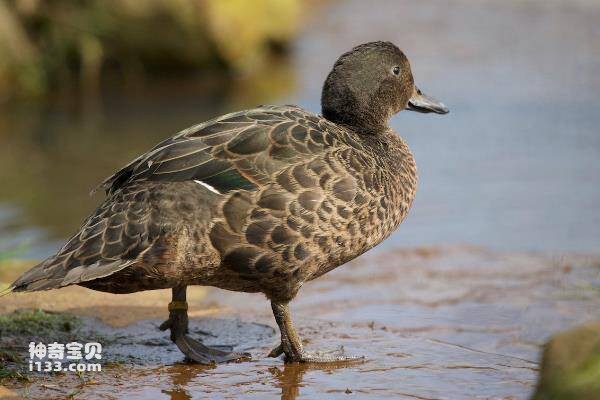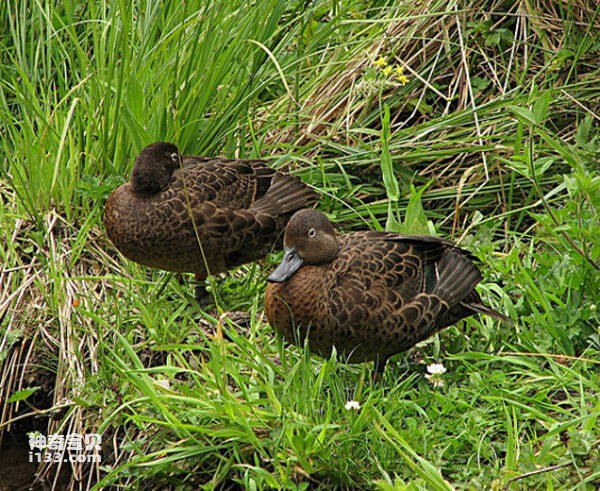Anas chlorotis
IUCN
LCBasic Information
Scientific classification
- name:Anas chlorotis
- Scientific Name:Anas chlorotis,Brown Teal
- Outline:Waterfowl
- Family:
Vital signs
- length:About 48 cm
- Weight:530-700g
- lifetime:No textual research information is available
Feature
Very timid, mostly nocturnal
Distribution and Habitat
Freshwater wetlands in the lowlands of New Zealand and several offshore islands number around 1000. Small populations also exist on Little Balil, Tai Ping, Rakitu, Chuan Yu, Moturoa, Tiritirimataki and Kapiti, mainly through artificial stocking and reintroduction.
It inhabits a variety of environments on the island, including tussock, scrub and coast. Most are found in coastal swamps, ponds and swampy lowland forests.
Appearance
The New Zealand duck is 48 cm long; Males weigh 620-700 grams and females weigh 530-600 grams. The plumage is dark brown. During the breeding season, the male duck develops a shiny green head, and the plumage on the breast becomes darker and maroon. The chest and wings are reddish-brown and the top brown. There are white stripes along the sides of the body, and some also have a white collar. Non-breeding plumage, females, juveniles and males are almost identical, with mottled brown plumage with light feathering. The duck's beak is blue. Where the wing mirror should appear is an empty green frame. This species is distinguished from other members of the genus by its chestnut colored eyes with white circles.
Details
The New Zealand duck (Anas chlorotis), also known as Brown Teal, was once one of three subspecies of the brown duck and was classified as a separate species in 1993.

New Zealand ducks are nocturnal foragers, active from dawn to night, and prefer to hide during the day to avoid predators. It is mainly nocturnal, hiding in grass and overhanging plants during the day. It is usually done in pairs or in small family groups. Never in large flocks, married ducks live together as adults. Good at diving and getting food underwater. Ducks have webbed toes between the toes, the tail is out of the water when swimming, and they are good at feeding, splashing and mating in the water. Splashing in water is beneficial to the cleanliness and growth of feathers.
New Zealand ducks feed mainly on aquatic invertebrates and plant debris in fresh and salt water, and also forage in grasslands close to water sources. As well as feeding on worms and insects, small shells are also caught at night in estuaries.

New Zealand ducks nest and breed in dense vegetated areas 100-200 metres along the coastline from July to November. At this time, the duck is very territorial and will drive away or even kill other ducks that invade its territory. The nest is above the nearby water, hidden in the water grass. Female ducks usually lay five to six eggs. During this time, ducks are active at night. During the day they incubate their eggs in the riverbank vegetation. Incubate it for 27-30 days. The ducklings will take 55 days to plumage, but will remain with their family until the next breeding season.
In 2005, Birdlife International verified more than 1,100 birds on Tai Ping Island and North Island. The 2012 total was estimated at 700 pairs, which indicates that the number of the species is in the range of c.1,900 individuals, which can be considered to include c.1,300 mature individuals, based on assumptions accounting for 2/3 of the total.
Listed on the International Union for Conservation of Nature (IUCN) 2013 Red List of Threatened Species ver 3.1 - Endangered (EN).
Listed in the Washington Convention CITES Appendix I protected animals.
Listed in Appendix I, Appendix II and Appendix III of the Convention on International Trade in Endangered Species of Wild Fauna and Flora (CITES) 2019 edition.
Protect wild animals and eliminate wild meat.
Maintaining ecological balance is everyone's responsibility!








